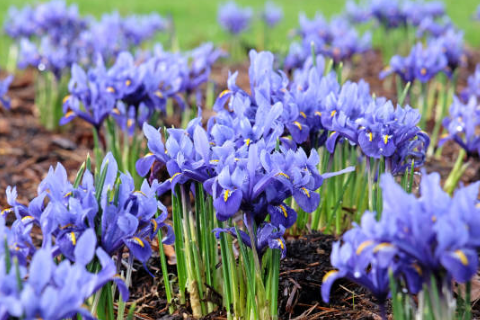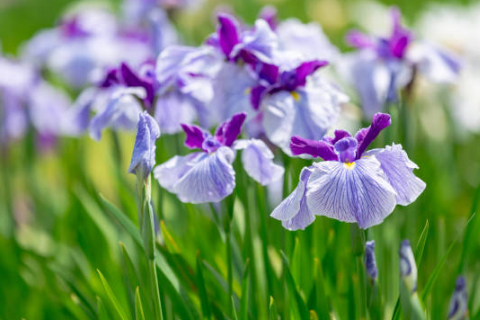Today I’d like to share some technical know-how on iris (Iris spp.) cultivation. Over the past few days I’ve been compiling my notes from past iris production and planting, and I’m excited to pass them on to you.
Native to Europe, irises typically grow 80–90 cm tall and bloom in May. Breeders have since developed many vibrant, hardy perennial cultivars—light purple, deep violet, pure white, yellowish-white, and more—making irises a staple in cold-hardy garden borders.
Iris Growth Habits
Irises include several categories:
-
Rhizomatous bearded irises (e.g., German Iris): Prefer well-drained but moderately moist soil.
-
Wetland rhizomatous irises (e.g., Siberian Iris, Japanese Iris): Thrive in damp soils or shallow water. Their flower buds form in autumn, with new growth and flowering in spring, followed by new root development.
-
Bulbous irises: Have smaller bulbs (1–3 cm in diameter) covered in a papery brown tunic. They love cool weather, dislike high heat, and require abundant sun. They root in September–October, grow leaves in early spring, bloom in early summer, and enter dormancy—ideal for planting in autumn.

⛏️ Cultivation Protocols
Soil
Irises grow well in beds or in-ground gardens. Any soil that is well-draining, moisture-retentive, and not prone to compaction works. Loamy sand is ideal. For clay-heavy soils, incorporate wood ash, perlite, coarse sand, and mix thoroughly. In very sandy soils, apply a surface mulch of rice hulls, pine needles, or peat moss to slow drainage.
Soil and Bulb Disinfection
It’s best to sterilize the soil annually, either by turning and solarizing for about 20 days or using chemical treatments (e.g., chlorothalonil or hexachloron spray).
Bulbs should be soaked for 30 minutes before planting in a 0.1% solution of thiophanate-methyl or chlorothalonil. If bulbs can’t be planted immediately, store them in a ventilated cold room below 2 °C—but for no more than two weeks to avoid mold.
Planting
Plant when soil temperatures are below 20 °C (preferably 16–18 °C). If the average growing season temperature exceeds 23 °C, adjust your planting to avoid stress. For high-quality cut flowers, use large bulbs (size 9–10 or 10+). Handle bulbs carefully to avoid root damage. Plant bulbs so the top is 5–9 cm below soil level. Plant at a density of 64–81 bulbs per m².
Maintain soil temperature at 5–8 °C (min) up to 20 °C (max), with air temps between 5–25 °C (optimal around 15 °C).
Watering
Irises like consistently moist soil. When it rains, nature covers it. Otherwise, give them a thorough watering every 10 days. Before winter, water deeply to prevent freeze injury. Early spring should also start with a good soak for thaw hydration. Water at planting and again after to improve soil–bulb contact and encourage rooting.
Fertilization
Avoid using chemical fertilizers before planting, as irises are sensitive to soil salts. Instead:
-
Mix organic matter (cow or horse manure, or dried chicken manure) into the soil before planting.
-
Once plants are established in spring, apply a urea fertilizer in early summer.
-
Later in the season (early autumn), apply phosphorus‑potassium fertilizer.
-
At the end of autumn, water in a light top-dressing of animal manure.
Avoid high-fluoride phosphate fertilizers such as superphosphate or triple superphosphate—use low-fluoride sources like disodium phosphate.

Pest & Disease Management
a. White rot (Sclerotium rolfsii)
Attacks stems and leaf bases; may kill the entire plant under hot, humid, compacted soil conditions.
-
Rotate plantings every 4+ years
-
Improve air circulation and avoid crowding
-
Preventively spray a 500× dilution of 50% thiophanate-methyl or thiophanate-methyl wettable powder before outbreaks
b. Leaf blight
Highly contagious; begins as gray-brown tip lesions that spread downward, eventually browning the entire leaf, often with black fungal spores.
-
Fungus survives in soil debris over winter and spreads with rain or irrigation; peak months: June–September
-
Control by hygiene (no infected plantings), soil/bulb sterilization, preventing waterlogging, removing and burning affected leaves, and painting out debris in winter
-
Spray diseased plants with 800× chlorothalonil (75%) alternating with 1500× methyl thiophanate (70%), 4–5 successive times at 8–10 day intervals
c. Damping-off (Southern blight)
Bulbs rot at their base, often covered in white mold. Spores thrive in warmer temperatures.
-
Disinfect bulbs using quintozene or imazalil
-
Sterilize soil via steam or bromide
-
Rotate with freesia or gladiolus
d. Root-knot nematodes
Cause stunting, bud dieback, shriveled black roots, eventual bulb rot.
-
-
Use soil steaming or methyl bromide fumigation prior to planting
-
With careful soil prep, methodical planting, consistent moisture, balanced feeding, and vigilant pest/disease prevention, your irises will thrive—rewarding you with stunning late spring blooms year after year. If you’d like a printable guide or seasonal care calendar, I’d be happy to create one!

